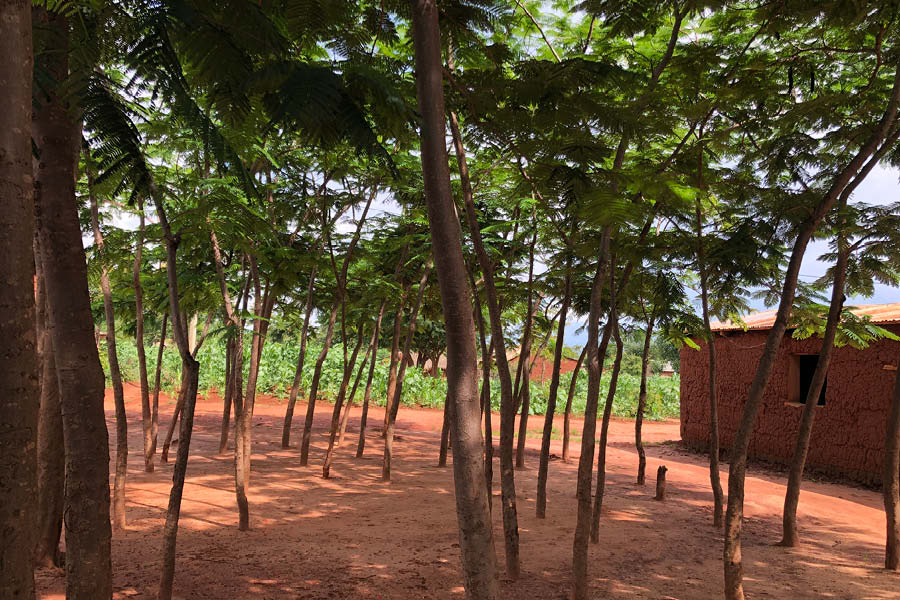What is carbon forestry?
Tree planting in the Global South for carbon offsetting, so-called carbon forestry, has grown dramatically. The idea is that trees with the ability to capture and store carbon dioxide (i.e. carbon sequestering) from the atmosphere have economic value. And this value is transferable into so-called carbon credits. Therefore, tree planting and conservation can be monetized activities, where carbon credits can be sold on the global carbon market. Apart from sequestering carbon, the trees offer several benefits for people living within the project areas, and many projects focus on poverty reduction. Carbon forestry projects can range from large plantations of monoculture crops such as pine and eucalyptus to projects focusing on agroforestry where small-scale farmers plant trees on their lands.
Carbon offsetting projects are registered and sold through different systems, such as the UN system Clean Development Mechanism (CDM). These systems limit on how many carbon credits can be sold each year. There is also the so-called Voluntary Carbon Market (VCM), allowing for the sale of carbon credits without the same limitations on quantity.
Today, many companies, organizations and state governments invest in carbon offsetting to compensate for their emissions. This allows them to brand themselves as “climate neutral” or having a “net-zero” carbon emission. Some companies even brand themselves as “carbon positive”, suggesting that they not only reduce their own emissions, but also purchase carbon credits to the extent that their total climate benefits exceed their emissions.
Is it really possible to compensate for your emissions?
These businesses have been questioned and criticized since they do not point at actual reduction of carbon emissions, but rather to uptake of carbon elsewhere (as in carbon forestry) or less use of fossil fuels (as in green energy systems such as solar panel parks). Researchers state that the term “climate offsetting” or “compensation” should not be used, as it is misleading.
Trees are very valuable in providing shade, restoring soil moisture and providing firewood for local people. However, the idea of trees for carbon offsetting has been highly questioned for different reasons. One major concern is that the carbon dioxide uptake by plants through photosynthesis in the fast carbon cycle cannot compensate for the emissions from fossil fuels, the so-called slow carbon cycle, i.e. fossil carbon and oil that have been stored in bedrock for millions of years.
Whether climate offsetting truly leads to reduced emissions or, potentially, even more remains a significant concern. One main criticism revolves around the concept of the additionality of carbon projects. Additionality refers to the carbon sequestered in a project area that would not have happened without the project. When establishing a carbon forestry project, the project has to guarantee that the trees would not have been planted without the project. To ensure the success of tree planting initiatives, it is essential to guarantee that the trees remain in place for a certain period, usually 30-50 years, which can be challenging to guarantee. A study examining most carbon-offsetting projects within the UN system from 2013 to 2020 showed that only 2% had a high probability of being additional. This means that companies that sell carbon credits from a project that does not fulfil the requirement of additionality can profit significantly from a project that does not contribute to any emission reductions that would not have happened anyway. So, buyers of carbon credits believe they have achieved ‘climate neutrality’ through offsetting, although their actual impact is minimal.
Attempt to create a fair system
The UN system was created and negotiated to ensure that the carbon offsetting projects would not only be additional, but also fair towards poorer countries. One main argument was to provide financial and climate adaptation strategies to countries in the Global South. Meanwhile, carbon offsetting could be a way to legitimize ‘business as usual’ among richer countries in the Global North. Researchers have expressed their worries that carbon offsetting might undermine more ambitious and fair climate solutions, as it creates the misconception that we can compensate for our emissions instead of reducing them in our home countries.
Since the Industrial Revolution, these countries have been, and still are, the biggest emitters. If everyone lived and consumed as we do in Sweden, we would need around four planet Earths to have enough resources. In 2020, Sweden’s carbon dioxide footprint per person was 3,2 tons. In Tanzania, one of the countries targeted by various carbon forestry projects, the carbon dioxide footprint per person was 0,2 tons.
This raises concerns about uneven power relations, as well as climate justice. Global South nations have their national climate targets like Global North nations. Through climate offsetting, these countries are responsible for reducing their own emissions while also working to mitigate the emissions of richer countries.
Despite the will to create a fair system, many problems still need to be solved. Some of the carbon forestry projects have managed to improve the livelihoods and climate adaptation strategies in local communities. However, the challenges with additionality remain alongside the fact that climate offsetting is not working the way it is stated to do.
